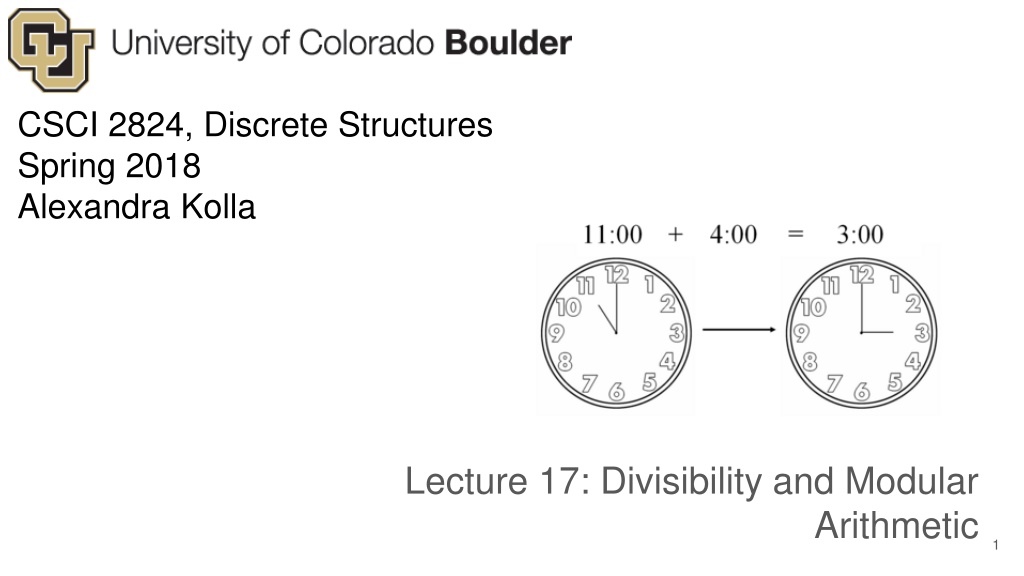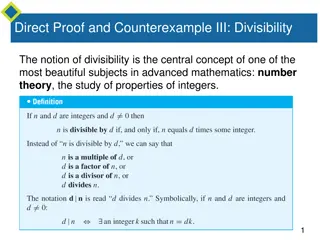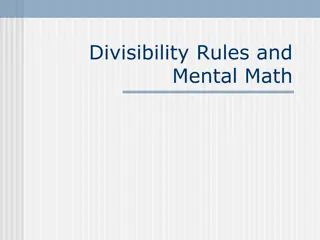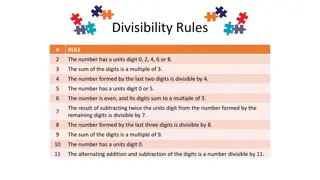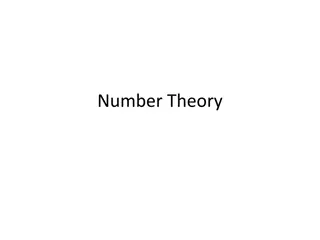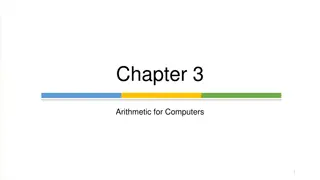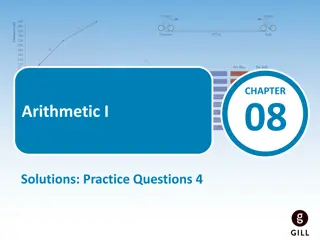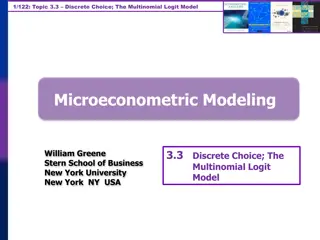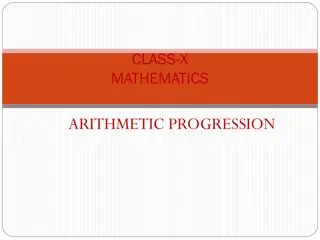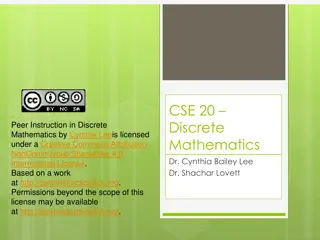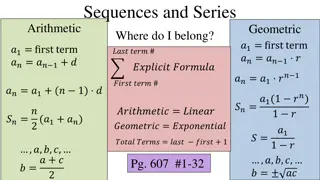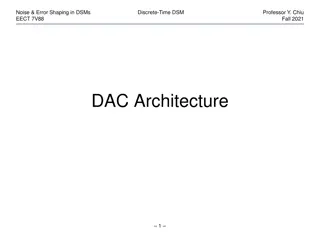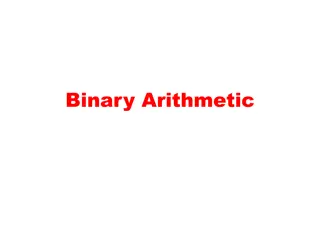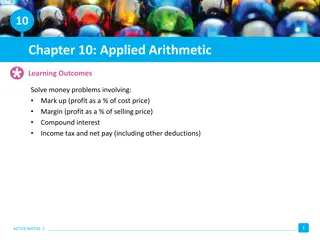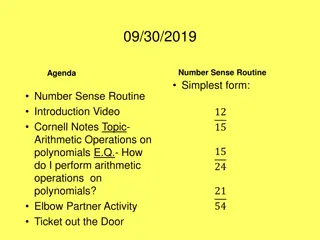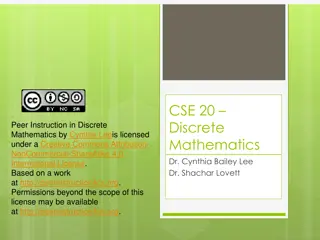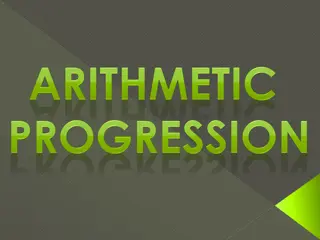Understanding Divisibility and Modular Arithmetic in Discrete Structures
This lecture discusses the concepts of divisibility and modular arithmetic in the context of discrete structures. It covers definitions, notation, and examples of divisibility by integers, including proving properties such as the divisibility of products and consecutive integers. Through practical examples and proofs, the lecture aims to deepen understanding of these fundamental mathematical concepts.
Download Presentation

Please find below an Image/Link to download the presentation.
The content on the website is provided AS IS for your information and personal use only. It may not be sold, licensed, or shared on other websites without obtaining consent from the author. Download presentation by click this link. If you encounter any issues during the download, it is possible that the publisher has removed the file from their server.
E N D
Presentation Transcript
CSCI 2824, Discrete Structures Spring 2018 Alexandra Kolla Lecture 17: Divisibility and Modular Arithmetic 1
Announcements and Reminders HW6 (written) is due Friday at 12 PM 2
What did we do last time? We learned to multiply/add matrices and matrices, and multiply matrices and vectors, and estimate the complexity of these operations. Today: Divisibility and Modular arithmetic Why do we care? Do you like RSA security? (Answer: yes, yes you do.) 3
Divisibility and modular arithmetic Definition: An integer n is divisible by a nonzero integer a if we can write it as n = as for some integer s. The following statements are equivalent: n is divisible by a a divides n a is a factor of n n is a multiple of a Math notation: a | n If an integer b does not divide n, we write b n 4
Divisibility and modular arithmetic Definition: An integer n is divisible by a nonzero integer a if we can write it as n = as for some integer s. The following statements are equivalent: n is divisible by a a divides n a is a factor of n n is a multiple of a Math notation: a | n If an integer b does not divide n, we write b n Example: A number n is even if and only if 2 | n Example: A number n is odd if and only if 2 n 5
Divisibility and modular arithmetic Example: Prove that if n is divisible by 5 and m is divisible by 3, then m2n is divisible by 45. 6
Divisibility and modular arithmetic Example: Prove that if n is divisible by 5 and m is divisible by 3, then m2n is divisible by 45. Proof: S pose n is divisible by 5 and n is divisible by 3. There are some integers k and l s.t. n = 5k and m = 3l m2n = (3l)2 5k = 9l2 5k = 45l2 k But l2 k is some integer! 45 | m2n 7
Divisibility and modular arithmetic Example: Prove that the product of consecutive integers is even. Proof: (by cases) 8
Divisibility and modular arithmetic Example: Prove that the product of consecutive integers is even. Proof: (by cases) Let m = n (n+1), where n is an integer. Case 1: n is even Let n = 2k Then m = 2k (2k + 1) = 2 (2k2+ 1), which is even Case 2: n is odd Let n = 2k + 1 Then m = (2k + 1)(2k + 2) = 2 (2k + 1)(k + 1), which is even Thus, the product of consecutive integers must be even. 9
Divisibility and modular arithmetic Theorem: Let a, b and c be integers. Then 1. If a | b and a | c, then a | (b + c) 2. If a | b then a | bc for all integers c 3. If a | b and b | c, then a | c Proofs: 10
Divisibility and modular arithmetic Theorem: Let a, b and c be integers. Then 1. If a | b and a | c, then a | (b + c) 2. If a | b then a | bc for all integers c 3. If a | b and b | c, then a | c Proofs: 1. S pose a | b and a | c. then b = as and c = at for some s, t Z b + c = as + at = a(s+t), where s+t Z a | (b + c) 11
Divisibility and modular arithmetic Theorem: Let a, b and c be integers. Then 1. If a | b and a | c, then a | (b + c) 2. If a | b then a | bc for all integers c 3. If a | b and b | c, then a | c Proofs: 12
Divisibility and modular arithmetic Theorem: Let a, b and c be integers. Then 1. If a | b and a | c, then a | (b + c) 2. If a | b then a | bc for all integers c 3. If a | b and b | c, then a | c Proofs: 2. S pose a | b then b = as for some s Z bc = asc = a(sc), where sc Z a | bc 13
Divisibility and modular arithmetic Theorem: Let a, b and c be integers. Then 1. If a | b and a | c, then a | (b + c) 2. If a | b then a | bc for all integers c 3. If a | b and b | c, then a | c Proofs: 3. FYOG! 14
Divisibility and modular arithmetic Whenever we divide an integer by another integer, there is a quotient and a remainder. The Division (kinda)Algorithm: Let a be an integer and d be a positive integer. Then there exist unique q and r, with 0 r < d, such that a = dq + r Example: If we divide 45 by 11, we have 45 = 11(4) + 1 Definition: In the equality given in the Division Algorithm , d is called the divisor, a is called the dividend, q is called the quotient and r is called the remainder. The notation used to express the quotient and remainder is a div d = q and a mod d = r 15
Divisibility and modular arithmetic Example: What are the quotient and remainder when -13 is divided by 3? Answer: We have -13 = 3(q) + (r) = 3(-5) + 2 Or expressed using div and mod: -13 div 3 = -5 and -13 mod 3 = 2 16
Divisibility and modular arithmetic In many applications, we only care about the remainder when an integer is divided by a specific positive integer. On a 12-hour clock, what time is it when it is 52 hours after 11:00? Example: 17
Divisibility and modular arithmetic In many applications, we only care about the remainder when an integer is divided by a specific positive integer. On a 12-hour clock, what time is it when it is 52 hours after 11:00? Example: 52 mod 12 = 4 11:00 + 4 hrs = 15:00 Answer: 15:00 mod 12 = 3:00 Example: What day of the week will it be 100 days from today? Answer: 18
Divisibility and modular arithmetic In many applications, we only care about the remainder when an integer is divided by a specific positive integer. On a 12-hour clock, what time is it when it is 52 hours after 11:00? Example: 52 mod 12 = 4 11:00 + 4 hrs = 15:00 Answer: 15:00 mod 12 = 3:00 Example: What day of the week will it be 100 days from today? 100 mod 7 = 2 Answer: 19
Divisibility and modular arithmetic We have already introduced a mod m to represent the remainder when a is divided by positive integer m We also will find it useful to say when two numbers a and b have the same remainder when divided by positive integer m. Definition: If a and b are integers and m is a positive integer, we say that a and b are congruent modulo m when (all of these are equivalent): a and b have the same remainder when divided by m m | (a-b) a mod m = b mod m a b (mod m) If a and b are not congruent modulo m, we write a b (mod m) 20
Divisibility and modular arithmetic The only new idea here is that a and b have the same remainder when divided by m is equivalent to m | (a-b)... so let s prove it! Proof: Let r = a mod m = b mod m 21
Divisibility and modular arithmetic The only new idea here is that a and b have the same remainder when divided by m is equivalent to m | (a-b)... so let s prove it! Proof: Let r = a mod m = b mod m We can write, for some integers s and t : a = ms + r and b = mt + r a-b = ms+r - (mt+r) = ms + r - mt - r = m(s-t) where s-t is some integer m | (a-b) 22
Divisibility and modular arithmetic Theorem: Let m be a positive integer. The integers a and b are congruent modulo m if and only if there exists an integer k such that a = b+km Proof: Let m be a positive integer 23
Divisibility and modular arithmetic Theorem: Let m be a positive integer. The integers a and b are congruent modulo m if and only if there exists an integer k such that a = b+km Proof: Let m be a positive integer ( ) S pose a b mod m. m | (a-b) k Z s.t. (a-b) = km a = b + km (from the definition of congruence mod m) ( ) S pose k Z s.t. a = b + km (a-b) = km m | (a-b) a b mod m 24
Divisibility and modular arithmetic We can also do arithmetic modulo a positive integer m (you already do this naturally mod 12 when you use a 12-hour clock) Theorem: Let m be a positive integer. If a b mod m and c d mod m , then a + c b + d mod m and ac bd mod m Proof: S pose a b mod m and c d mod m 25
Divisibility and modular arithmetic We can also do arithmetic modulo a positive integer m (you already do this naturally mod 12 when you use a 12-hour clock) Theorem: Let m be a positive integer. If a b mod m and c d mod m , then a + c b + d mod m and ac bd mod m Proof: S pose a b mod m and c d mod m The one on the left: s, t Z s.t. a = b + sm and c = d + tm a + c = b + sm + d + tm = b + d + m(s + t) a + c b + d mod m 26
Divisibility and modular arithmetic We can also do arithmetic modulo a positive integer m (you already do this naturally mod 12 when you use a 12-hour clock) Theorem: Let m be a positive integer. If a b mod m and c d mod m , then a + c b + d mod m and ac bd mod m Proof: S pose a b mod m and c d mod m The one on the right: s, t Z s.t. a = b + sm and c = d + tm ac = (b + sm)(d + tm) = bd + btm + smd + stm2= bd + m(bt + ds + stm) ac bd mod m 27
Divisibility and modular arithmetic Example: Because 7 2 mod 5 and 11 1 mod 5, it follows that 18 = 7 + 11 2+1 mod 5 3 mod 5 and 77 = 7 11 2 1 mod 5 2 mod 5 28
Divisibility and modular arithmetic Example: Because 7 2 mod 5 and 11 1 mod 5, it follows that 18 = 7 + 11 2+1 mod 5 3 mod 5 and 77 = 7 11 2 1 mod 5 2 mod 5 Question: If ac bc mod m, is it true that a b mod m ? 29
Divisibility and modular arithmetic Example: Because 7 2 mod 5 and 11 1 mod 5, it follows that 18 = 7 + 11 2+1 mod 5 3 mod 5 and 77 = 7 11 2 1 mod 5 2 mod 5 Question: If ac bc mod m, is it true that a b mod m ? Answer: No! Consider as a counterexample a = 2, b = 4, c = 6 and m = 12. We have: 12 24 mod 12 = 0 but 2 4 mod 12 30
Divisibility and modular arithmetic We can also distribute the modulo operator Theorem: Let m be a positive integer and a, b are integers. Then (a + b) mod m = ((a mod m) + (b mod m)) mod m and (ab) mod m = ((a mod m)(b mod m)) mod m 31
Divisibility and modular arithmetic We can also distribute the modulo operator Theorem: Let m be a positive integer and a, b are integers. Then (a + b) mod m = ((a mod m) + (b mod m)) mod m and (ab) mod m = ((a mod m)(b mod m)) mod m Fun/useful fact: We can mod-out before doing complicated arithmetic. (you might do this in your head already!) Example: What is 81 124 mod 11 ? 32
Divisibility and modular arithmetic We can also distribute the modulo operator Theorem: Let m be a positive integer and a, b are integers. Then (a + b) mod m = ((a mod m) + (b mod m)) mod m and (ab) mod m = ((a mod m)(b mod m)) mod m Fun/useful fact: We can mod-out before doing complicated arithmetic. (you might do this in your head already!) Example: What is 81 124 mod 11 ? 81 124 mod 11 = ((81 mod 11)(124 mod 11)) mod 11 = (4 3) mod 11 = 12 mod 11 = 1 33
Divisibility and modular arithmetic Example: Compute 10nmod 11 for integer values of n 34
Divisibility and modular arithmetic Example: Compute 10nmod 11 for integer values of n Solution: 101mod 11 = 10 (10 = 11*0 + 10) 102mod 11 = 100 mod 11 = 1 (100 = 11*9 + 1) 103mod 11 = 1000 mod 11 = 10 (1000 = 11*90 + 10) 104mod 11 = (103mod 11)(101mod 11) mod 11 = (10 10) mod 11 = 100 mod 11 = 1 10nmod 11 = 1 if n is even, 10 if n is odd 35
Divisibility and modular arithmetic Example: Prove that any 4-digit palindromic number is divisible by 11. 36
Divisibility and modular arithmetic Example: Prove that any 4-digit palindromic number is divisible by 11. Note that any such number looks like: ABBA and can be written as ABBA = 1000A + 100B + 10B + A = 1001A + 110B = 91*11A+10*11B 37
Divisibility and modular arithmetic FYOG: What is 1000! mod 123 ? FYOG: Find the smallest positive integer that leaves a remainder of 2 when divided by 3 and a remainder of 5 when divided by 7. FYOG: Prove that any number of the form ABCABC is divisible by 13. 38
Divisibility and modular arithmetic Recap: We learned what it means for a number to divide another number And how to do modular arithmetic (aside from mod 12, which you use all the time) Reflect on where else in your life modular arithmetic sneaks in This makes arithmetic with numbers easier, but also means we can store big numbers in a computer as a combo of only a few small numbers. Next time: Back to the binary! (numbers, that is) And modular exponentiation (we did modular arithmetic today, so let s make it even more wild) 39
Bonus material! 40
FYOG: hints! FYOG: What is 1000! mod 123 ? Note that 1000! = 1 2 3 121 123 124 999 1000 = 123 (some very large number) 41
FYOG: hints! FYOG: Find the smallest positive integer that leaves a remainder of 2 when divided by 3 and a remainder of 5 when divided by 7. Let n be the desired integer. We know: n = 3k + 2 (some integer k) n = 7l + 5 (some integer l ) Now: n mod 7 = (3k+2) mod 7 = ((3k mod 7) + (2 mod 7)) mod 7 = [3(k mod 7) + 2] mod 7 = 5 we want k mod 7 = 1 42
FYOG: hints! FYOG: Prove that any number of the form ABCABC is divisible by 13. Note that any such number may be written as ABCABC = 1000 ABC + 1 ABC So ABCABC mod 13 = (1000 ABC + 1 ABC) mod 13 = [(1000 ABC mod 13) + (1 ABC mod 13)] mod 13 = [(1000 mod 13 ABC mod 13) + (1 mod 13 ABC mod 13)] mod 13 43
